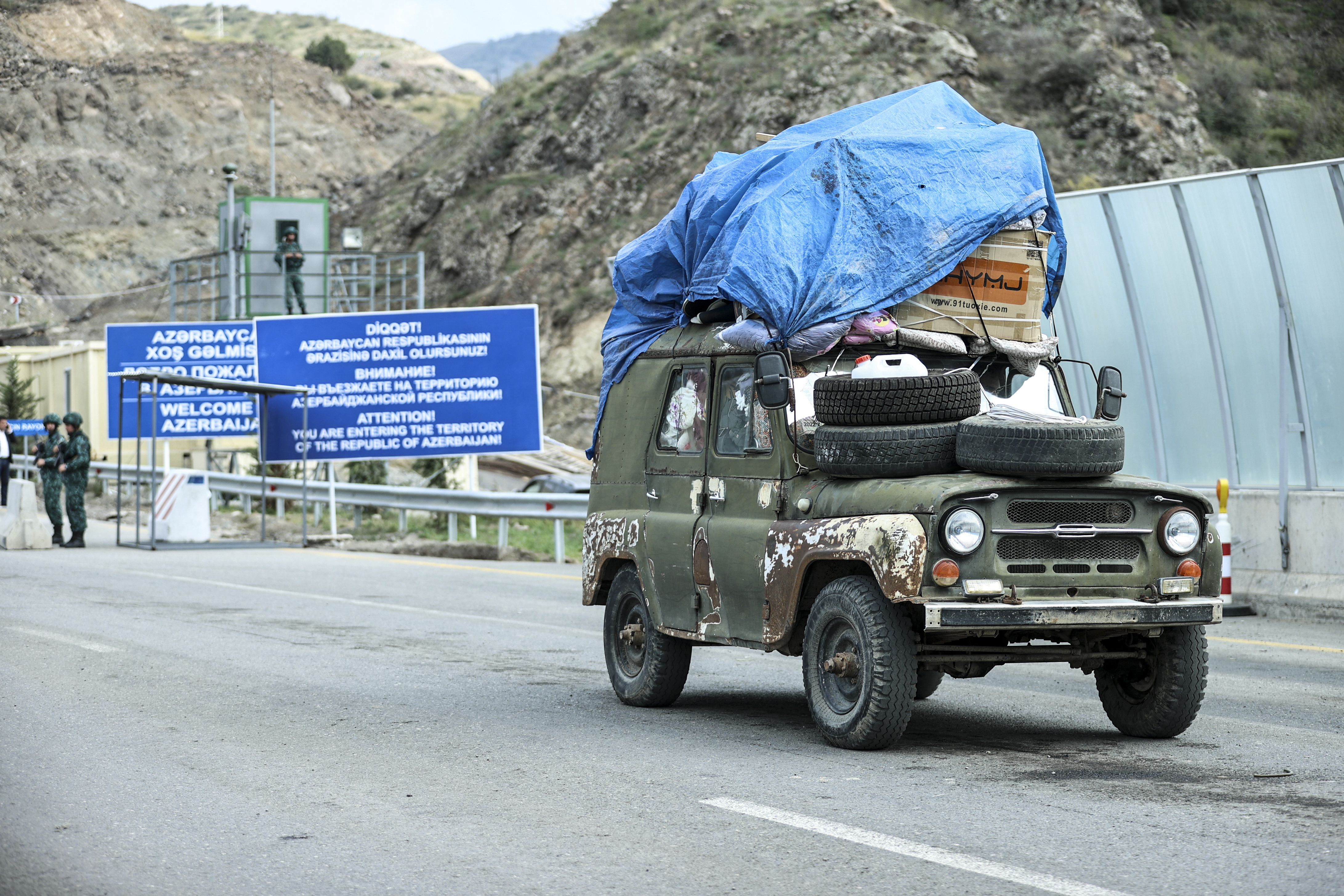Russia
Armenia-Azerbaijan Border Tensions and Relationship Dynamics. What Is Russia’s Agenda?

Since Azerbaijan has taken control over Nagorno-Karabakh in September 2023, much of the attention has shifted to Syunik, Armenia’s strategically important southeastern province. In Armenia, fears are mounting that an Azerbaijani invasion towards that direction could be imminent. An armed incident in a border village in Syunik on February 13 caused significant concerns.
In 2020, the 44-day war was terminated by a tripartite statement. However, it didn’t bring comprehensive stability to the South Caucasus region. Azerbaijan’s military intervention in 2023 changed the reality on spot. So is the document still in force?
While no one is able to give a clear answer, Russia insists on the implementation of one specific provision of the document. It refers to unblocking communication links in the region with sole Russian control over the roads, ignoring Armenia’s sovereignty and aiming at maintaining political-military leverages in the region.
Alarming Situation on Armenian-Azerbaijani Border Again
In the early morning of February 13, the Armenia’s Defense Ministry reported that Azerbaijani forces had opened fire towards Armenian positions near its border village of Nerkin Hand. It said four Armenian soldiers were killed and another was wounded in the latest clash, which lasted for four hours.
Azerbaijan said it had been conducting what it called a “revenge” operation in response to an earlier incident which resulted in one of its servicemen being wounded. Armenian military police initiated an investigation into this incident and stated the perpetrators would be brought to justice if the circumstance was confirmed. However, Baku did not await the results and opened fire. In light of this, Armenia’s response was that the Azerbaijani authorities simply needed a pretext to heighten tensions and torpedo international peace talks.
The Nerkin Hand position of the border is patrolled by Russian guards, which makes it impossible for the EU monitoring mission to cross it. Since serious escalation incidents at the border in 2022, an EU monitoring mission is tasked to observe potential conflict areas along the Armenia-Azerbaijan border. Azerbaijan denounced the EU monitoring mission on multiple occasions. Its foreign ministry even summoned the EU’s ambassador in Baku to express its concern about the mission. Russia, which has also been critical of the EU mission, was quick to react over the latest fighting and call on both Armenia and Azerbaijan to show “restraint”.
Meanwhile, the EU’s senior foreign affairs representative Josep Borrell described Azerbaijan’s action as “disproportionate”. He remarked: “This once again confirms the urgent need for the withdrawal of forces from proximity to each other, which the EU has long advocated. I reaffirm the EU’s unwavering commitment to establishing sustainable peace in the region, grounded in principles such as sovereignty, border inviolability, and territorial integrity”. The Azerbaijani Foreign Ministry criticized Borrell for taking a unilateral, pro-Armenian stance, claiming that it “creates a divide between Azerbaijan and EU institutions, ultimately isolating himself from the normalization process between Azerbaijan and Armenia”.
Many in Yerevan fear that Azerbaijan’s President Ilham Aliyev might be resorting to military operations again as a tool to address specific issues. There is a risk that Azerbaijan attempts to create a backdrop to gain more concessions from Yerevan by threat of and use of force. He threatened several times to take military action against Armenia if needed. He also said he would not remove Azeri troops from several territories that they had occupied in Armenia’s sovereign territory during September 2022 large scale attacks. On February 13, the Armenian military personnel came under fire from such Azerbaijani positions established in 2022.
Unblocking Routes on Russia’s terms
Aliyev wants to create a land link to its exclave Nakhijevan through Armenia’s territory which he calls the “Zangezur Corridor”. According to Azerbaijan, it should exclusively be under the “neutral control” of Russian border guards, without any Armenian checks on Azerbaijani cargo and passengers.
Armenia fears Azerbaijan’s proposal might be a trap to force it to cease control of its southern border. Instead, Armenia counter-offers an option of focusing on regional cooperation and general reopening of all transport routes in the region, based on the principles of sovereignty and jurisdiction of the countries.
In contrast to Armenia’s vision of the region, the Russian model has the logic of a “corridor”, i.e. sole Russian control over the roads, which means Moscow’s strong and decisive presence in the South Caucasus.
Is the Ceasefire Statement from November 9, 2020 still Valid?
The tripartite ceasefire statement signed between Azerbaijan, Armenia and Russia on November 9, 2020 terminated the 44-day war in Nagorno-Karabakh. However, the events followed the 2020 statement completely changed the reality on the ground.
The November 9 statement stipulated the post-war situation in Nagorno-Karabakh, i.e. the presence of the Armenian population and the necessity to protect them, the existence of the Lachin corridor as a link between Nagorno-Karabakh and Armenia, and the acknowledgment of Nagorno-Karabakh as an entity itself. None of the aforementioned is in place anymore since the depopulation of Nagorno-Karabakh in September last year.
Despite it, Russia keeps insisting on the implementation of one specific provision of the document (namely, article 9, which pertains to unblocking economic and transport links in the region, with Russian forces overseeing the transport communication).
It is noteworthy that Azerbaijan structures its “Zangezur Corridor” discourse also on the basis of the November 9 statement, saying that its establishment was foreseen in the document. However, the word “corridor” in the statement is mentioned only in reference to the Lachin corridor.
In effect, Russia is trying to pressure Armenia to open communication in the region on Putin’s terms. Azerbaijan does not seem to have a problem with this.
Russian “Peace” Model. What does Russia want in the South Caucasus?
Russia did, and most probably will continue hinder Western peace initiatives, in order to prevent Western involvement in the South Caucasus. Throughout 2023, various Western actors came up with a number of initiatives, aimed at lifting the blockade of Lachin corridor. For example, in early 2023 the US started to organize a meeting between Azerbaijan and Nagorno-Karabakh representatives, which was to take place in Sofia, Bulgaria. Russia leaked the information about the upcoming meeting, which lead to the failure of it.
Azerbaijan’s rhetoric towards the West and its platforms is growing more confrontational. Several developments, e.g. a high-level welcome of Russia’s Deputy Prime Minister for Eurasian integration, Azerbaijan’s suspension from PACE, rejection of US and EU mediation platforms hint that Azerbaijan and Russia are closer to each other now. It could be attributed to certain arrangements between Russia and Azerbaijan on the status quo in the South Caucasus.
On February 17, Olaf Scholz hosted a meeting between the leaders of Armenia and Azerbaijan on the sidelines of the Munich Security Conference. It was the first meeting on a European platform in several months, after Azerbaijan’s prolonged refusal of Western-mediated talks. However, a new kick-start of the full European facilitation is not expected amid growing tensions with the EU.
The current situation in the region is not only fragile for Armenia, but also directed against the West. Not surprisingly, Russia blames the West for “not letting Armenia attend” Russian platforms to discuss the ongoing issues with Azerbaijan.
It is in Russia’s interest that the tensions and problems in the region persist. It wants no settlement, because the resolution of the Armenian-Azerbaijani conflict would substantially decrease Russia’s influence leverages on the South Caucasus countries. In other words, long-lasting peace and stability in the South Caucasus is not beneficial for Russia, but it would be advantageous both for Armenia and the EU.
